A furniture store inside a Byculla mill has launched a collection of vintage mirrors that reflect 18th century aesthetics. Even if you can’t afford them, go and ogle

Italian mirror
If you’ve wasted enough time scrolling Instagram, you’re likely to know that selfies taken in front of unusually-shaped mirrors—squiggly, oblong, puddle-like—are all the rage at the moment. But hey, like they say, today’s social media obsession has its roots in reflective material created centuries ago.
ADVERTISEMENT
Byculla’s lifestyle and furniture store, The Great Eastern Home has launched a collection of vintage mirrors (Rs 50,000 onwards) that shine a light on design movements of yesteryears.
From massive, ornate wall mirrors to opulent Art Deco and relatively contemporary ones, there’s a wide range of styles and sizes on display. What makes the collection exceptional is the fact that each of these has been handcrafted in brass, bronze or wood. Some have even been hand painted in gold to add lustre. “The Italian vintage mirrors make a great focal point in any room, and larger versions can make an impressive statement. From creating an illusion of space to representing a standalone masterpiece, mirrors have come a long way in redefining personal decor styles,” says founder Dr Anurag Kanoria.
This Italian mirror was crafted in the 1800s, and is hemmed by poplar wood with gold leafing. It is rooted in the Rococo style, which defined much of French art in the 18th century. “The scallop shell carving on the top gives a glimpse of the aesthetic. The thin gilded framing gives it a lightness despite its size. Such mirrors looked wonderful in dimly candle-lit rooms and salons of that era. The reflections added to the atmosphere,” says Kanoria.
This mirror harks back to the 1800s and is of French origin. According to Kanoria, it belongs to the second phase of the Neoclassical period. “The classical touches were encouraged by Napoleon’s desire for a style inspired by the grandeur of ancient Egypt and imperial Rome—the use of pediment, capital, columns and acanthus leaf motifs. Ancient ornamental motifs, often with symbolic implications, are a reference to Napoleon’s reign.” He gives the example of the winged victory, (eagle here) and the laurel wreath used as decorative symbols of triumph. Bees, sheaves of grain, and cornucopias (see these on the top of the columns) for prosperity.
If we’re talking statement mirrors, this one takes the cake. “It is steeped in the Syrian and Levantine style. The inlay mother of pearl and bone work with metal wire work on wood is typical of artefacts from the Ottoman Empire. Mother of Pearl was used extensively in Turkish culture and the Islamic world.”
What: Vintage mirror collection
Where: The Great Eastern Home, near Rani Baug, Byculla East
Discover: www.thegreateasternhome.com
 Subscribe today by clicking the link and stay updated with the latest news!" Click here!
Subscribe today by clicking the link and stay updated with the latest news!" Click here!






